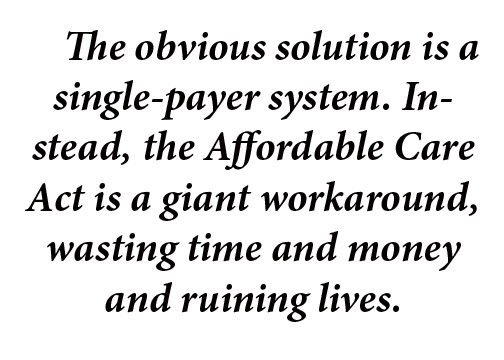By David Himmelstein and Steffie Woolhandler
The New York Times, Room for Debate, May 29, 2013
Gordon Schiff, an expert on medical quality, frequently admonishes: “Avoid workarounds.” It’s better to fix system defects than to force doctors and nurses to squander time and creativity (and to court disaster) by sidestepping problems like broken equipment, missing charts or computer bugs.
The Affordable Care Act is a giant workaround. Overwhelming evidence says that public insurers like Medicare (with overhead costs of 2 percent) are more efficient than private ones (overhead of private Medicare Advantage plans is 14 percent). And multiple insurers means multiple contracts, with varying coverage, billing procedures, documentation requirements, etc. – all of which force doctors and hospitals to waste billions more. The obvious fix is to cut out the insurance middlemen and cover everyone under a single public program paid for by taxes – with equal coverage for all. But the insurance lobby blocked that, so instead the Affordable Care Act took the Rube Goldberg route.
If your income is below $31,321 for a family of four (133 percent of the poverty line), you will get Medicaid (unless you live in a red state that declined the federal assistance, like Texas or Alabama). And “Medicaid” nowadays means a privately run Medicaid H.M.O. But make one dollar more (or if Junior moves out, leaving a family of three) and Medicaid disappears; now you’re shopping for subsidized private insurance in the state-run exchange. That’s not a rare occurrence: 28 million adults cross the 133 percent line annually.
In the exchange, “bronze” plans look cheapest – at first glance. But if your income is under 250 percent of poverty there are special discounts for copayments, but only in “silver” plans.
Move from 400 percent of poverty to 401 percent, and individual premiums rise $2,303. Can’t quit smoking? Add $3,365.
Stop paying your premium? You’ll stay enrolled for three months, but your insurer only has to pay your medical bills for one month.
The health care law’s consumer protections apply to everyone, except the 58.5 percent of private sector workers whose employers self-insure.
Employers who do not offer coverage must pay a fine, unless you work less than 30 hours a week, averaged over three months, or maybe 12 months.
Small employers can get help with premiums, unless they buy coverage through a Taft-Hartley Fund.
Got it? We don’t either. And there’s much more arcane detail that can mean life or death for thousands, penury or plenty for millions.
Government already pays two-thirds of total health costs, but much of that money takes a detour through a maze of private insurers. This manufactured complexity sows confusion and adds huge expense – the cost of a workaround.
David Himmelstein and Steffie Woolhandler are professors at the City University School of Public Health at Hunter College and visiting professors at Harvard Medical School. They are co-founders of Physicians for a National Health Program.
http://www.nytimes.com/roomfordebate/2013/05/29/is-obamacare-too-complicated-to-succeed/a-single-payer-system-would-be-better-than-obamacare
